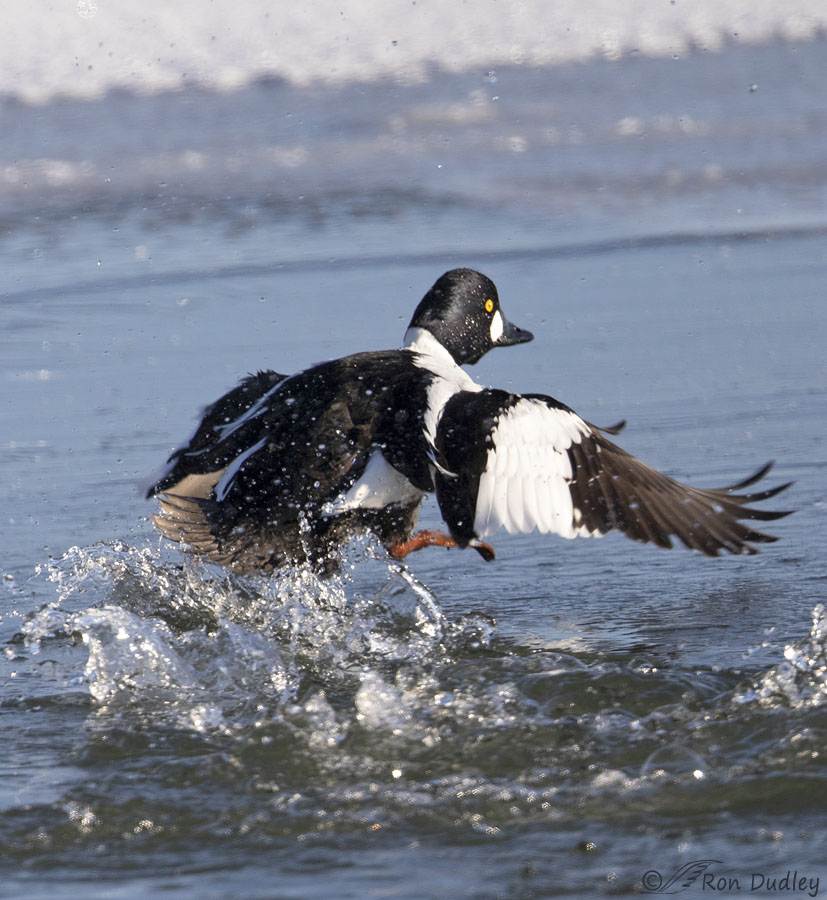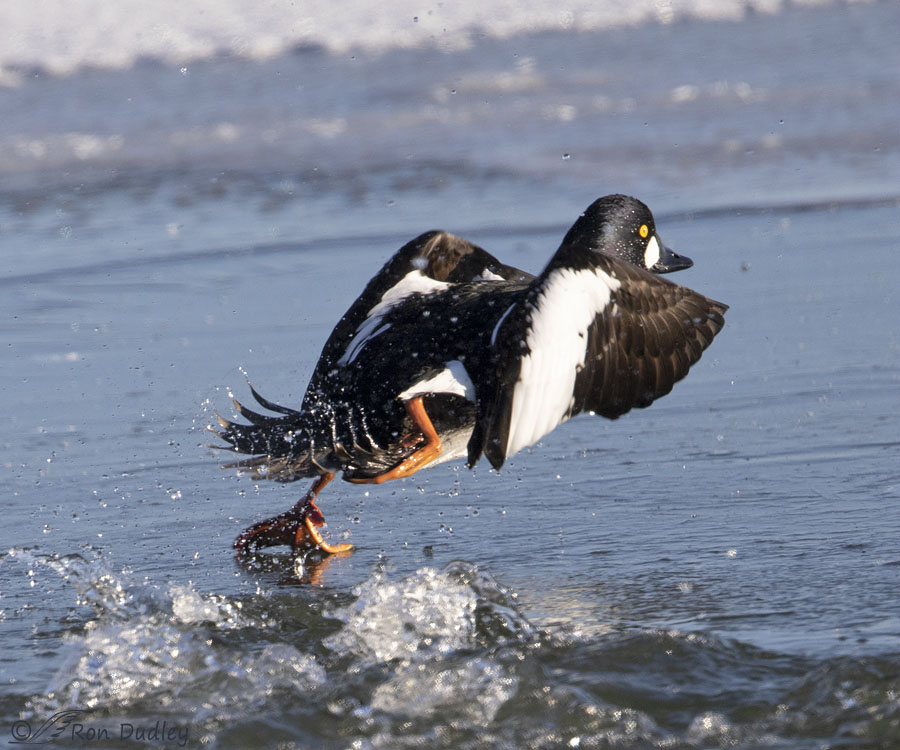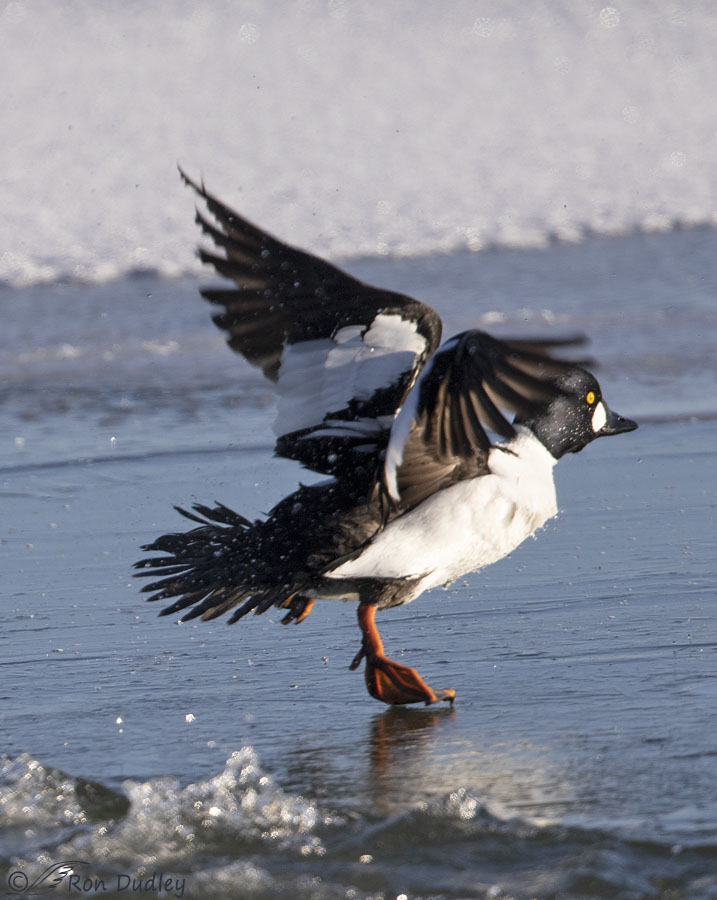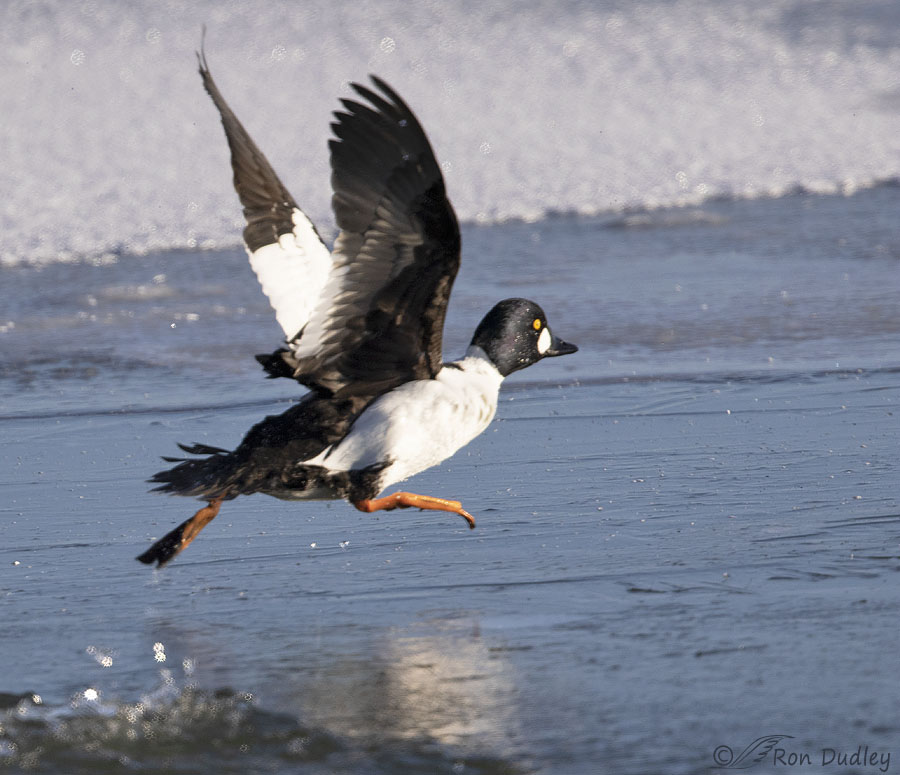Surprised me too. And made me laugh at his expense.
Like many ducks, Common Goldeneyes run across the water during takeoff. Their churning webbed feet pushing backward against the dense water accelerate them quickly. Readers already know that I often attempt to photograph them during takeoff but it isn’t easy. Their buzz saw legs and feet accelerate them so quickly, even explosively and often in an unpredictable direction, that I’ve found getting photos of them during the process to be nigh on impossible.
Two days ago at Bear River MBR I tried again, many times. I never got any great photos but I did catch one male goldeneye during a takeoff that I’m sure didn’t go as planned.

As I approached the group of goldeneyes that were confined to a narrow strip of open water parallel to the road my pickup made them nervous, it always does. The strip of open water is too close to the road for their comfort so they nearly always take off, often at the exact moment my pickup stops. So as I creep forward, in order to have any chance of accomplishing my goal, I have to have my lens out the window and semi-aimed at them before I come to a complete stop. For whatever reason they nearly always take off to the north, to my left.
But unexpectedly this immature male turned to the south just before exploding from the water a nanosecond before I could snap my first photo. This is his first wing beat immediately after his webbed feet propelled him forward and slightly upward out of the water. Normally he’d continue to churn the water with his feet to gain speed horizontally before eventually rising above the water’s surface in full flight.
But this guy was in for a surprise.
Look below his right foot. What you see is the interface between water and ice immediately in front of him. Pushing backward with your feet against slippery ice in order to accelerate quickly just… doesn’t… work.

So instead of accelerating quickly, for just a moment he almost looked like he was running in place as his feet slipped on the ice.
He did gain some acceleration from his wings but he didn’t accelerate anywhere near as fast as they usually do. And that’s almost certainly the reason I was able to keep him in frame for a few photos before he was gone.

He’s sure not moving forward very fast.

In this last photo it may look like he’s really striding out but it was mostly in vain. Notice that even in this fourth shot we can still see the ice/water interface and part of his initial water splash close behind him at lower left.
I actually noticed him slipping through my viewfinder because his little feet were going a helluva lot faster then he was and I remember chuckling at what I’d just seen. I wish still photos would allow us to see the actual slipping like video would but here we’re stuck with the limitations of photography.
Maybe you had to be there to fully appreciate it.
Ron


These ducks are so cute! I guess this duck wasn’t having a great time but his poses are so expressive, almost like a cartoon character.
I agree about their visual appeal, HC. I just wish they were a little more cooperative.
Poor guy! And send some love to our poor young Olympian who fell in her debut. Some #}}%*!!! are sending hate mail.
I saw that, Arwen. The trolls on Chinese social media are out in force.
Great job documenting these nervous little bundles of energy, Ron. I think you did a nice job showing how much they rely on pushing off from the water to achieve the explosive acceleration they have when there is no ice.
Goldeneyes are so frustrating to photograph. I often find myself saying, “would you just chill out?” as watch them be so overly reactive to my presence, or as you say, Ron, even slowing your vehicle down.
I had one moment when I was hiding in a blind waiting for river otters to show up and some goldeneyes started to drift towards me. All it took was one shutter click to send them away.
I wonder if they have high-blood pressure 😉
Most birds have higher standing blood pressures than do mammals. I don’t know a number for ducks but an average range for most birds is 180-250 and some birds even higher. Hearts are larger and the stroke volume is also greater, pumping more blood more quickly. This, along with other adaptations of the circulatory system help with the remarkable lifestyle of birds.
Dan, very interesting about their BP. I didn’t know that.
Thanks, Dan, very interesting
Ed, I don’t know for sure about THEIR BP but I can tell you this – my BP goes up every time goldeneyes take off just before I get my lens on them. With their wings whistling, almost like it’s their way of saying “Ha, beat you again sucker!.”
Great series and no video needed to imagine how it all took place. Diving ducks have this problem and need a clear space to briefly run. Green-winged Teal, Mallard or other dabblers mostly just take off straight up off the water without the need to run so the ice in front would be much less of a problem.
“Green-winged Teal, Mallard or other dabblers mostly just take off straight up off the water”
Exactly, Dan. I think that’s why hunters call them “puddle jumpers” or just “puddlers”?
Great sequence, Ron! Having recently endured the misfortune of a slip-n-fall (and face plant) on a rain-slicked walkway, I can appreciate this poor fella’s initial surprise, followed by absolute determination to stay upright and get aloft. Would that I had wings to provide that extra oomph when it’s needed most!
I hope you didn’t get hurt, Chris! Falls are scary!
Thanks — mostly hurt my pride (well, and a knee). But yes, scary, knowing it could have been worse, and grateful it wasn’t!
What a series – it would have been great to see a video, to get the full effect. But with your fine descriptive powers, Ron, and the photos of the efforts of that bird, I was smiling broadly.
Aren’t the feet of birds just a wonder. Mia had a great post of a coot today.
Nina, a video of the event would have to be slowed down for best effect. But slowed down or not it would be fun to see.
Spot on comments this am! Fist bumps to Marty, Everett & Allison.
Agreed, Kathleen. Others too.
What a great sequence!
Once he joined his laughing buddies, I’m sure he quacked: “I meant to do that.”
Wally, your last sentence made me think of my brother-in-law. Long story…
Poor little guy! I was expecting a face plant at some point in this endeavor. Definitely brings up memories of “ice skating” coots. 😉
Marty, I ran across that coot post again a few days ago. Made me laugh again too.
That poor duck – who recovered a damn sight better than I could hope to do.
Yet another fascinating series.
A damn sight better than yours truly too, EC.
Ron, these are wonderful takeoff photos. I love the clarity and the action of the little duck’s wings and feet. The churning water and the glistening droplets captured on the duck’s feathers and in mid-air are amazing. Another wonderful series for your blog buffs to enjoy. I can feel your excitement.
Thanks very much, Melanie.
Hilarious tho, certainly, not for the duck! 🙂 In the 3rd shot it appears he’s trying to hook a toenail in the ice tho guessing it didn’t work…
Judy, if it worked at all it didn’t work very well.
I’ve seen how comical ducks can be when landing on ice but had no idea they would be subject to the banana peel effect when taking off. It appears nature has a sense of humor. Or maybe we’re just easily entertained. Or both.
“had no idea they would be subject to the banana peel effect when taking off”
Before this instance I’d never thought about the possibility either, Lyle.
I like Alison’s comment. Amen to that. You can see excellent bird photos in numerous places, but with FP you get the outstanding photography plus science, biology, the environment, and many very meaningful human interest stories.
Back to the Goldeneye – it sure helps to have wings when you are slipping on ice. Excellent photos Ron.
I appreciate what you said about FP, Everett. A lot, actually.
I love the shots!!
Can’t you see the smile on his face?
Dick, I don’t know about his but I had one on mine.
I love these shots and the tale of frustration was a lot of fun to “live” vicariously. The BP info (and speculations thereon) added to the entertainment. Smiles all round. Also have to second Everett’s assessment of FP’s many attributes.
Many thanks, Granny Pat.
Only through you, Ron, will I ever see a running goldeneye slipping on the ice during takeoff! Thanks for all the light you pour into my life!
Glad to know I’m occasionally the source of something fairly original. Thanks, Alison.
Nope. Sitting in icy Boston and fully appreciating the sequence. Lucky for him that he is not competing in Beijing. And love the phrase “churning webbed feet.” Thanks Ron!
And churning they were, Frances. Furiously.
Interesting series. #2 is my favorite for the wing positioning.
Thanks, Michael.